Modeling the COVID-19 epidemic and awareness diffusion on multiplex networks
Le He and Linhe Zhu
School of Mathematical Sciences,Jiangsu University,Zhenjiang,212013,China
Abstract The coronavirus disease 2019 (COVID-19) has been widely spread around the world,and the control and behavior dynamics are still one of the important research directions in the world.Based on the characteristics of COVID-19's spread,a coupled disease-awareness model on multiplex networks is proposed in this paper to study and simulate the interaction between the spreading behavior of COVID-19 and related information.In the layer of epidemic spreading,the nodes can be divided into five categories,where the topology of the network represents the physical contact relationship of the population.The topological structure of the upper network shows the information interaction among the nodes,which can be divided into aware and unaware states.Awareness will make people play a positive role in preventing the epidemic diffusion,influencing the spread of the disease.Based on the above model,we have established the state transition equation through the microscopic Markov chain approach (MMCA),and proposed the propagation threshold calculation method under the epidemic model.Furthermore,MMCA iteration and the Monte Carlo method are simulated on the static network and dynamic network,respectively.The current results will be beneficial to the study of COVID-19,and propose a more rational and effective model for future research on epidemics.
Keywords: COVID-19,Multiplex network,Awareness spread,Propagation threshold
1.Introduction
The global spread of COVID-19,in which the outbreak began at the end of 2019,has had a huge impact on the world economy and human safety.The WHO report shows that the global mortality rate for COVID-19 is about 6.4%.Although the epidemic has been effectively controlled in some areas,the global epidemic situation is still very serious.Reasonable and effective mathematical modeling can provide great help to the government in anti-epidemic decision-making,disease prevention and control.Many researchers have established the spreading model of COVID-19 based on the traditional cabin model.Among them,some dynamics models have modified the traditional susceptible-infected-exposed-recovered (SIER) model and calculated the basic reproduction number[1–4].Wu considered the impact of intercity traffic flow on disease transmission in the COVID-19 epidemic model and used the confirmed data of each city for comprehensive analysis [1].Tang introduced the isolation and medical tracking mechanism to control the development of the epidemic [2].Suwardi predicted that the emergence of vaccines would greatly accelerate the end of the epidemic [3].Apart from the cabin classification of SIER models,some new methods of state classification have been proposed to better conform to the actual situation.In Chen's study[5],individuals could also be in a state of diagnosis and isolation,or death.At the same time,their model considered the phenomenon of delay in transfer between different states and the effect of taking isolation measures on the epidemic situation.With the intensifying of the epidemic research,it is further found that there may be asymptomatic patients during the spread of the new crown epidemic.In the study of Sun[6],individuals could be in one of the following five states: susceptible (S),asymptomatic (A),close observed (C),infected (I) and recovered (R).Based on these five states,a homogeneous mixed differential equation model was established.Further,the model fitted the epidemic situation of specific cities and reveals the great influence of‘escapers’on disease spreading.In summary,the presentation of these models,all contribute to the prediction and control of COVID-19 propagation.
In recent years,the dynamics on the network have been developing continuously,which provides a new perspective for people to understand and study the spreading mechanism of infectious diseases.Because the relevant information is often closely related to the propagation behavior,the twolayer multiplex network model based on the dissemination mechanism of relevant information has begun to be applied in various dynamic modeling processes,such as epidemic propagation [7–16],rumor propagation [17,18],multiplex information propagation [19–21],risk propagation [22,27],behaviour progation [23] and so on.Granell divided the population of information diffusion process into two categories,namely the unaware(U)state and aware(A)state,and established a two-layer multiplex network model based on the traditional susceptible-infected-susceptible (SIS) model [7].The model revealed the coupling effect of disease-related information and disease transmission.The effect of the information transmission network on the disease propagation threshold was further quantified.Moreover,Xia established a UAU-SIR model to represent the influence of relevant information on the traditional SIR model,and derived the epidemic threshold of disease transmission,which was proved to be related to the topology of the multiplex network and the coupling relationship between the two propagation dynamics[8].Along these lines,they introduced the influence of the mass media in the later UAU-SIR model,and quantified the significant role of the mass media in inhibiting the spread of infectious diseases [9].Zhu introduced the individual death state based on the UAU-SIR model,and then established a susceptible-infected-recovered-dead (UAUSIRD) model [12].They explained that the addition of an information layer had a significant impact on the range of disease transmission and the number of deaths.
Regardless,the above mathematical models provide valuable clues for us to describe and study the spreading behavior of an epidemic.However,for the study of COVID-19,many models are based on the hypothesis of uniform mixing of people,without considering the actual influence of the differences in contact patterns between different individuals on the spread of disease.Meanwhile,these models have ignored the influence of COVID-19-related information diffusion on the spreading behavior of the disease.Therefore,based on Sun's work [9],we can use the framework of the two-layer multiplex network to establish a COVID-19 disease-information coupling model,where the upper network is an unaware-aware-unaware(UWU)model.By improving the model,we will study the coupling dynamics of diseaseinformation diffusion in a double-layer network structure.In previous work,during the process of establishing a multiplex network model,the disease contagion layer often depends on a relatively simple SIS or SIR model,so the threshold analysis generally involves only one infection cabin.However,in our work,the mechanism of disease spreading is established by the spread characteristics of COVID-19,in which the process of state transition is more complex,and the threshold analysis also involves multiple infection cabins.
The following structure of this paper is as follows:in the second section,we describe the basic structure of the doublelayer multiplex network model,including the dynamic behavior of information and disease spreading in the upper and lower layers.Next,in the third section,the state transition probability tree and state transition equation of the model are established using the microscopic Markov chain approach(MMCA) method.In the fourth section,we simulate the model numerically.Finally,we put forward the conclusion of this paper in the fifth section.
2.Modeling
2.1.The spreading dynamics on each layer
As shown in figure 1,a two-layer multiplex network model is established to study the transmission process of COVID-19 with the influence of consciousness transmission.The upper network of the model represents the information layer,reflecting the status of different individuals’ recognition and transmission of disease information.Among them,the nodes represent individuals,and edges represent the information interaction between nodes.People can spread information related to disease prevention in the information network.The lower network of the model represents the disease transmission layer,reflecting the status of different individuals and the transmission of infectious diseases.Among them,the nodes correspond to nodes in the upper network one to one,and connecting edges represent the actual contact between individuals.The state of each node is determined by the dynamic evolution of the upper and lower layers of the network.For the convenience of analysis and processing,it is assumed that the connecting edge structure of the two-layer network is independent,and the network is not directional.
Similar to the previous work [8,9],we use the UWU model to describe the spreading process of disease awareness in the upper network.After a disease outbreak,an individual may be in an aware state (W)or unaware state (U).When an unaware person has a neighbor that is an aware person,the neighbor spreads the information about the disease to him,making the unaware individual become aware at the probability of λ.At the same time,people's awareness of disease prevention will fade as time goes on,and in unit time,the aware will become unaware again with a probability of δ,as shown in figure 2.

Figure 1.The multiplex network model.
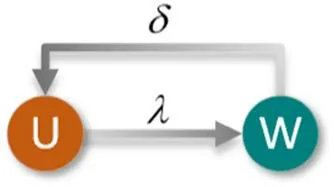
Figure 2.A description of the information spreading.
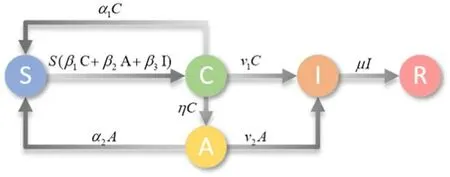
Figure 3.A description of the disease spreading.
The underlying network of the model is the disease spreading network.Based on Sun's work [6],we divide the population under the COVID-19 spreading network into five categories:susceptible(S),asymptomatic(A),close observed(C),infected(I)and recovered(R).If one is in the susceptible state,he may contact with close observed,infected and asymptomatic neighbors with a probability of β1,β2and β3,respectively,and will turn into the close observed state after contact.A close observed individual is going to change into an infected state or asymptomatic state with a probability of v1and η; meanwhile,he is going to release with a certain probability of α1going back to S.Asymptomatic patients will be diagnosed and turn into an infected state at the probability of v2,and return to the susceptible state at the self-healing rate of α2.Finally,the infected individual has a cure rate of μ to become recovered,as shown in figure 3.
2.2.Coupling propagation behavior on multiplex networks
Based on the above description,any individual can be in one of the following ten states:unaware–susceptible(US),aware–susceptible(WS),unaware–close observed(UC),aware–close observed (WC),unaware–asymptomatic (UA),aware–asymptomatic (WA),unaware–infected (UI),aware–infected(WI),unaware–recovered (UR),aware–recovered (WR).In fact,the propagation behavior of the upper and lower layers of the network is not independent,and the interaction of the propagation of the two layers of the network can be written as follows.
• When a susceptible individual in the network of disease spreading is in a state of awareness,he will take some measures to prevent disease.So,in the process of disease spreading,the aware will have a lower rate ofwith others compared with an unaware contact rate ofnamely theHere,γ belongs to[0,1],s=1,2,3,where γ represents the prevention rate,which shows the influence of the upper network on the lower network.
• When an individual in a disease spreading network becomes close observed or infected,he becomes aware,regardless of whether the individual was previously aware or not.This is realistic because people in both states must already have received information about the spread of the disease.This connection can show the influence of the lower network on the upper network.Therefore,UC and UI are ignored in the subsequent analysis.
After explaining the above two links,any individual can only be in one of the following eight states:US,WS,WC,UA,WA,WI,UR,WR.The influence of the upper layer on the lower layer can adjust by γ.When γ=1,it shows that the upper network has no impact on the underlying network; that is,the spreading of COVID-19 is independent of the diffusion of related information.
3.MMCA theoretical analysis
3.1.Probability tree and transition equation
In this section,based on the MMCA method,we will build the dynamical equation of eight possible states for the UWUSCAIR model.At some point t,any individual can only be in one of the eight states,and the probability that node i is in various states at time t is denoted asWith regard to the upper network,its adjacency matrix is denoted as A=(aij).Then,in the process of consciousness propagation,the probability that node i is not propagated by j in unit time can be expressed as

Similarly,the adjacency matrix of the lower network is denoted as B=(bij).If node j is a neighbor of i,then the probability that node j makes i turn to the close observed state from the susceptible state can be expressed asFurther,we represent the probability that US does not convert to C asqiU(t),and the probability that WS does not convert to C asqiW(t).Then,the following equation can be obtained

So far,we have obtained the transition probability tree of eight states,as shown in figure 4.Then,according to the probability tree in figure 4,we establish the dynamic evolution equation of eight possible states using the MMCA method,as shown below.
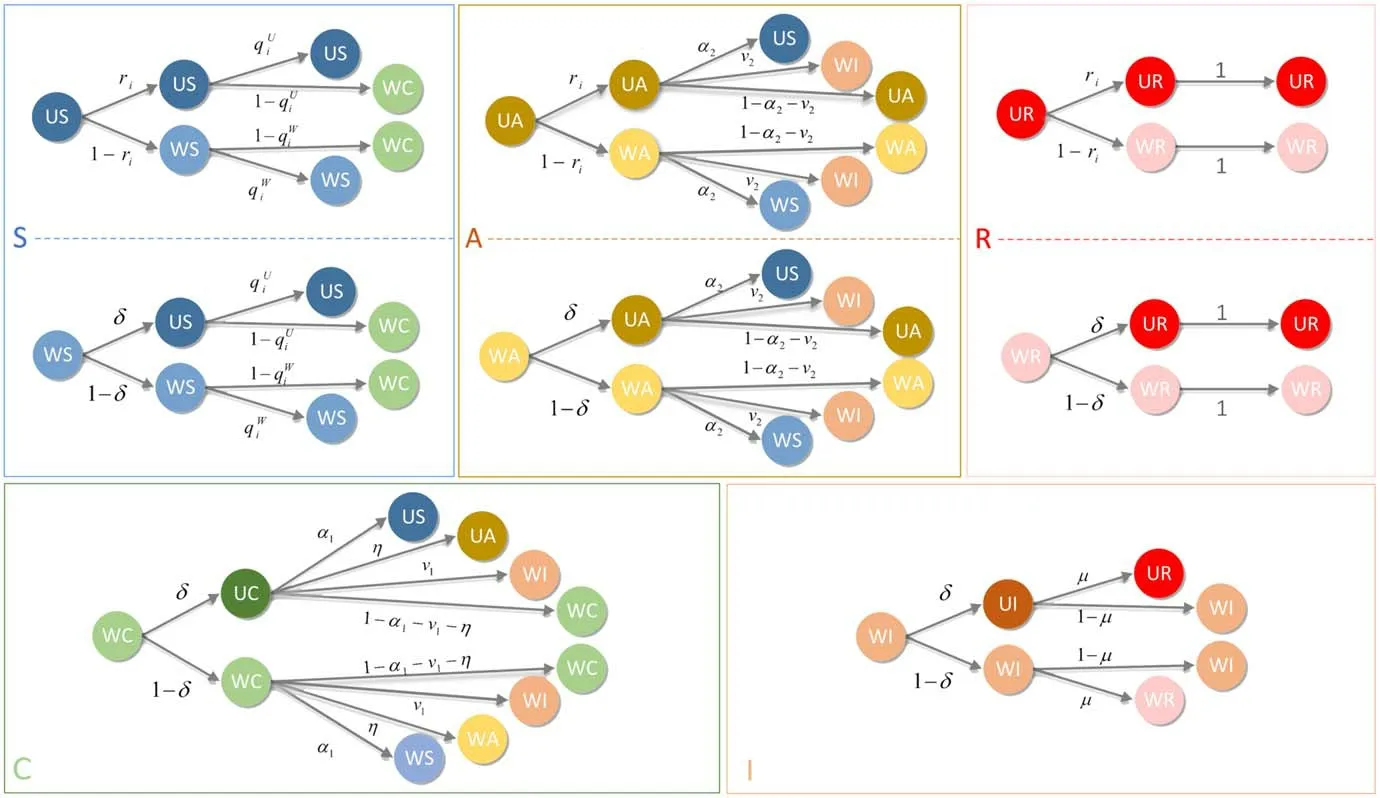
Figure 4.The probability trees for eight states.

The first expression indicates that node i at time t has a certain probability to be converted into US at the next time step t+1 under US,WS,UA,WA and WC.Other equations also have similar meanings.
3.2.Threshold analysis
The epidemic threshold is an important value in the study of epidemic dynamics.We can solve the epidemic threshold using the above MMCA model.Around the threshold,the probability of any individual being infected approaches zero,and we can assume thatThus,by ignoring the higher-order term ofandthenandcan be simplified as follows
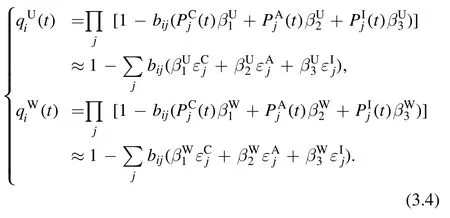

When t →∞,the system tends to approach the stationary state.We can assume that Pi(t+1)=Pi(t).The equation of US,WS in equation (5) can be further reduced into the following relationship by assuming ε →0:

When t →∞,the equations of WC in equation (5) and UA,WA,WI in equation (3.3) can be written as

Equation (3.7) can be further simplified as


where α=μ+α2k2+α1k1,and eijrepresents the member of the identity matrix.Thus,the critical threshold can be considered as the solution of the maximum eigenvalue problem of H,whose elements arehij=(1 − (1 −γ)PiW)bij.Then,the epidemic threshold regarding the current two-layered model can be described as follows

4.Numerical simulations
4.1.Simulation results of static network
In this section,a coupled two-layer static network is established as the basis for numerical simulation of the UWUSCAIR model,in which the upper network is a random Erdos–Renyi (ER) network with 1000 nodes with a connecting probability of 0.1,and the lower network is a Barabasi–Albert (BA) scale-free network with the power exponent of 3.Scale-free networks are highly heterogeneous and can describe the contact structure of people well.Then,the dynamic evolution of the UWU-SCAIR model in the above two-layer network will be simulated by an extensive MMCA iterative algorithm.The MMCA iterative algorithm is based on the state transfer process of the traditional nonhomogeneous discrete Markov chain.At t=0,we give the initial state distribution vectorfor any node i.With the help of the adjacent matrix of the two-layer network,the values of equation(3.1)and equation(3.2)at t+1 can be calculated for each node after the state distribution vector of each node is known at time t.Further,we can calculate the probability of each node in each state at time t+1 by equation (3.3),and update the state distribution vector.
First,in figure 5,we illustrate the variation of the proportion of recovered individuals (ρR) with λ and the contact rates β1,β2,β3,whereand N represents the total number of nodes presented in the system.The proportion of recovered individuals in the stationary state can characterize the number of nodes infected throughout the epidemic.The results show that the number of nodes affected by the epidemic is positively correlated with the contact rate,among which β3has the most influence,followed by β2.When the contact rate is low,small changes will cause a large change in the spread of the epidemic.Meanwhile,the range of disease diffusion is negatively correlated with λ.Compared with the disease transmission layer,and independent of the information transmission layer,effective prevention of awareness transmission will play a very effective role in resisting infectious diseases.
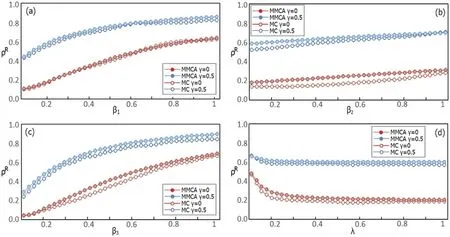
Figure 5.The ratio of the recovered (ρR) at the stationary state varies with the parameters β1,β2,β3 and λ,based on the MMCA iteration method and the MC method.In panel(a),the red and blue curves represent γ=0 and γ=0.5,respectively,and the parameters β2,β3 and λ are set as 0.2,0.25 and 0.5.In panel(b),the parameters β1,β3 and λ are set as 0.2,0.25 and 0.5.In panel(c),the parameters β1,β2 and λ are set as 0.2,0.2 and 0.5.In panel (d),the parameters β1,β2 and β3 are set as 0.2,0.2 and 0.25.Other parameters are set as follows: δ=0.4,α1=0.2,α2=0.5,η=0.1,v1=0.4,v2=0.1,μ=0.4.
It is worth mentioning that we also utilize the Monte Carlo method (MC) to run independently 50 times to get the evolution results of the UWU-SCAIR in the two-layer network.The MC method can better reflect the evolution process of the model in the actual propagation process.We find that the results of the two methods are in good agreement,which indicates that the MMCA iterative algorithm can describe the actual propagation process very well.Although on the whole,the number of recovered nodes obtained by the MC method is slightly smaller than that of the MMCA iterative method.We will only consider the evolution process of the UWU-SCAIR model in the two-layer network based on the MMCA algorithm in the following work.
In the following,we further explore the relationship between ρRor the fraction of aware individuals at the steady stateand the awareness weakening rate δ at different awareness spreading rates λ in figure 6.With the increase in δ,because of the increasing conversion rate of unaware individuals from the aware state,ρRis higher and ρWis lower,but their rate of change will gradually decrease.Similar to the results in figure 5,when λ is higher,ρRis lower,and its effect on ρRis similar at different values of δ.Conversely,the increase in λ leads to lower ρW,which is in line with the reality,and the greater the value of δ,the greater the impact on ρW.
In figures 7 and 8,we investigate the effects of v1and v2on disease transmission at different values of μ and η.In panel(a)of figure 7,η is set at 0.1,at which point the closely observed individuals are more likely to become infected.At a low cure rate (μ=0.2),v1has a great positive correlation to ρR,while at a high cure rate(μ=0.6),the impact of v1on ρRis relatively less.Then,in panel(b)of figure 7,η is set at 0.4,and the probability of the closely observed state turning into the asymptomatic state increases,while the positive correlation of v1on ρRdecreases.
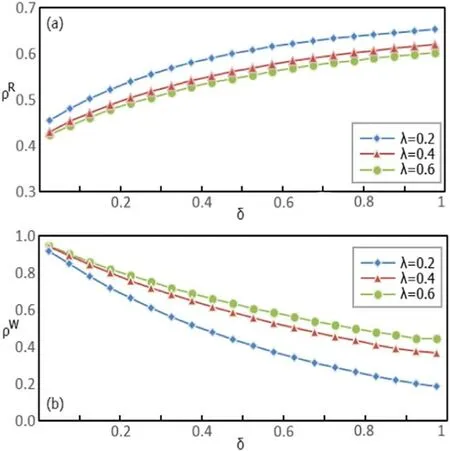
Figure 6.The ratio of the recovered (ρR) and the aware (ρW) at the stationary state varies with the parameters δ.The green,red and blue curves represent λ=0.6,λ=0.4 and λ=0.2,respectively.Other parameters are set as follows:β1=0.2,β2=0.2,β3=0.25,γ=0.5,α1=0.2,α2=0.5,η=0.1,v1=0.4,v2=0.1,μ=0.4.

Figure 7.The ratio of the recovered(ρR)in the stationary state varies with the parameters v1.In panel (a),the green,red and blue curves represent μ=0.6,μ=0.4 and μ=0.2,respectively,and the parameter η is set as 0.1.In panel (b),the parameter η is set as 0.4.Other parameters are set as follows: λ=0.5,δ=0.4,β1=0.2,β2=0.2,β3=0.25,γ=0.5,α1=0.2,α2=0.5,v2=0.1.

Figure 8.The ratio of the recovered(ρR)in the stationary state varies with the parameters v2.In panel (a),the green,red and blue curves represent μ=0.6,μ=0.4 and μ=0.2,respectively,and the parameter η is set as 0.1.In panel (b),the parameter η is set as 0.4.Other parameters are set as follows: λ=0.5,δ=0.4,β1=0.2,β2=0.2,β3=0.25,γ=0.5,α1=0.2,α2=0.5,v1=0.4.
Similarly,in figure 8,we have investigated the effect of v2on disease transmission.Significantly different from v1,although ρRalso increases with the addition of v2,its change is very gentle,and when the value of v2is very small,the effect of μ on ρRis still significant.From the above analysis,it can be judged that in the disease spreading system with current parameters,compared with asymptomatic patients,the effect of controlling the close observed population on the spread of the disease is more significant.
4.2.Simulation results of dynamic network
In this section,we establish a coupled dynamic double-layer network based on social responsibility and self-segregation,in which the evolution mechanism of the network is as follows.
• Because people's social networks present scale-free characteristics,in the initial state,we construct the upper network as a scale-free network with 1000 nodes and a power exponent of 2.5.The structure of the network is generated by the configuration model.At each time step,nodes in the aware state in the network have a probability of actively expanding their information exchange circle,trying to obtain more relevant information,or transmitting disease information to strangers out of a sense of social responsibility.At the same time,a new edge is established.It is reasonable to think that when a node has more neighbors,the stronger its sense of responsibility,the greater the probability of connecting edges.The maximum number of new connections in the network at one time step is τ1,and the probability offor any new connections is initiated from the node i and connected to any non-neighbor node.After a time step,the total number of new connections in the network iswhere kirepresents the degree of i,and〈k〉 represents the average degree of nodes.
• The lower layer is the spreading layer of disease,and the same as the previous simulation process,and the disease spreading network is still a BA scale-free network.During the spread of the epidemic,conscious individuals will isolate themselves,thus reducing or severing contact with their neighbors and causing the edge fracture.It is reasonable to think that the more neighbors a node has,the greater the probability that it will be far away from some of its neighbors.Suppose that after a time step,the maximum number of edges broken is τ2,the probability of any broken edges is broken by the node i and isthen,after a time step,the total number of connected edges reduced by the lower layer network is
The UWU-SCAIR model is numerically simulated on the above network by the MMCA iterative method.The variation of ρRwith τ1and τ2is shown in figure 9.When λ is high(λ=0.5),it can be seen from the vertical direction of the panel(b)of figure 9 that the influence of τ1on the spread range of the disease is very limited;that is,the change in the topology of the upper network has little effect on the spread of the disease.When λ is low(λ=0.1),the effect of τ1on the spread range of the disease increases significantly.In the illustrated range,τ1can bring up to 0.15 numerical changes to ρR.Different from the edge-connected process on the upper network,the edgebreaking process in the disease transmission network has a great influence on the spread range of the disease.Here,τ2can reduce the ρRvalue by 0.4 in the graphical range under specific τ1.It can be shown that self-segregation is a very effective way to resist infectious diseases.
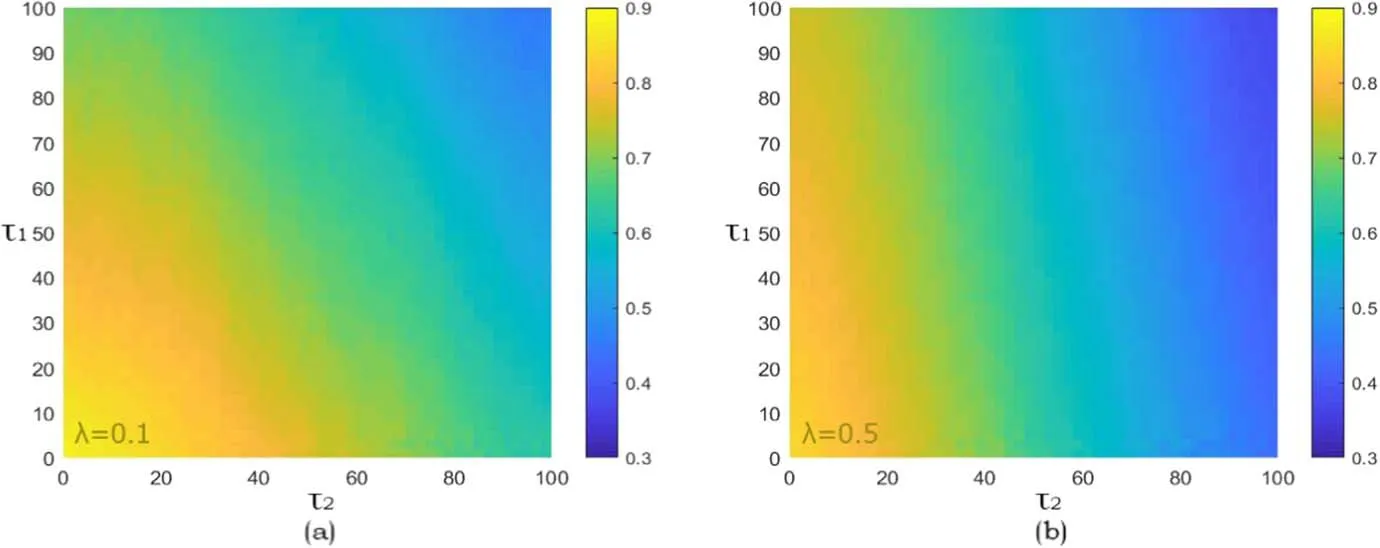
Figure 9.The ratio of the recovered(ρR)in the stationary state varies with the parameters τ1,τ2 in the two-layer dynamic network.In panel(a),the parameter λ is set as 0.1.In panel(b),the parameter λ is set as 0.5.Other parameters are set as follows:δ=0.4,β1=0.2,β2=0.2,β3=0.25,γ=0.5,α1=0.2,α2=0.5,v1=0.4,v2=0.1,μ=0.4.
5.Conclusions
Based on the propagation characteristics of the novel coronavirus,a coupled two-layer network UWU-SCAIR diseaseinformation model is proposed to simulate and study the interaction and propagation behavior of the novel coronavirus and related awareness.In the lower layer of the disease transmission network,the population is divided into five categories,and the topology of the network shows the actual contact relationship of the population.The upper network represents the awareness propagation layer,and the crowd can only be in the aware or the unaware state.Based on the state classification of these two layers,any individual can be regarded as in one of the eight states.Further,based on the above model,we have established the transition probability tree and state transition equation of eight states using the MMCA method,and we calculated the propagation threshold of the epidemic model.
In addition,we perform the MMCA iteration and MC method on a two-layer static scale-free network,respectively,to simulate the model.The results show that the MMCA iterative method and MC method are very consistent,and the control of close observers can inhibit the spread of the disease more effectively than that of asymptomatic infected persons.Then,we build a two-layer dynamic network and use the MMCA iterative method to simulate the UWU-SCAIR model based on the network.The results show that self-segregation can effectively control the spread of infectious diseases.The current research will help to propose a more reasonable model for the transmission of new the coronavirus and future epidemiological research,and make more reasonable predictions and control efforts [24–26].
Acknowledgments
This research is supported by the National Natural Science Foundation of China (Grant No.12002135),the Natural Science Foundation of Jiangsu Province (Grant No.BK20190836),China Postdoctoral Science Foundation(Grant No.2019M661732),the Natural Science Research of Jiangsu Higher Education Institutions of China (Grant No.19KJB110001)and Priority Academic Program Development of Jiangsu Higher Education Institutions (Grant No.PAPD-2018-87).
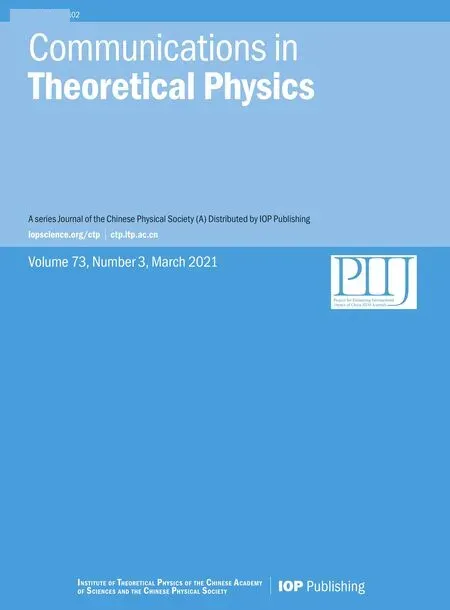 Communications in Theoretical Physics2021年3期
Communications in Theoretical Physics2021年3期
- Communications in Theoretical Physics的其它文章
- Exploring the influence of microRNA miR-34 on p53 dynamics: a numerical study*
- Investigation of quark distributions in a family of pentaquarks using the Thomas–Fermi quark model
- Coexistence and fluctuations phenomena with Davidson-like potentials in quadrupole–octupole deformed nuclei
- A new approach for modelling the damped Helmholtz oscillator: applications to plasma physics and electronic circuits
- Majorana–Kondo interplay in a Majorana wire-quantum dot system with ferromagnetic contacts*
- First-principles study on superconductive properties of compressive strain-engineered cryogenic superconducting heavy metal lead (Pb)
